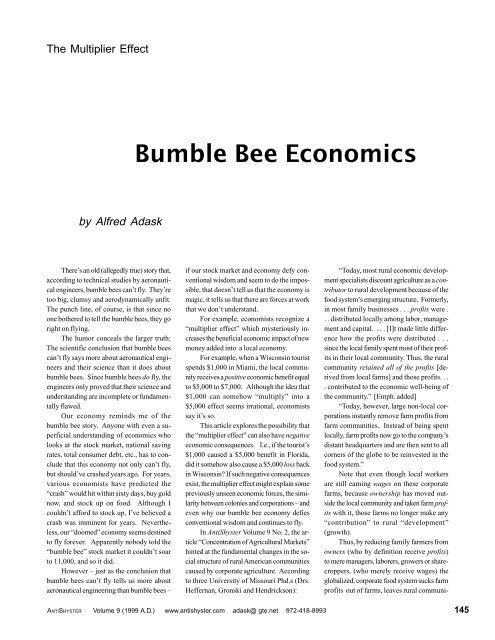Volume 9 No. 2 - Adask's law
Volume 9 No. 2 - Adask's law
Volume 9 No. 2 - Adask's law
Create successful ePaper yourself
Turn your PDF publications into a flip-book with our unique Google optimized e-Paper software.
The Multiplier Effect<br />
by Alfred Adask<br />
There’s an old (allegedly true) story that,<br />
according to technical studies by aeronautical<br />
engineers, bumble bees can’t fly. They’re<br />
too big, clumsy and aerodynamically unfit.<br />
The punch line, of course, is that since no<br />
one bothered to tell the bumble bees, they go<br />
right on flying.<br />
The humor conceals the larger truth:<br />
The scientific conclusion that bumble bees<br />
can’t fly says more about aeronautical engineers<br />
and their science than it does about<br />
bumble bees. Since bumble bees do fly, the<br />
engineers only proved that their science and<br />
understanding are incomplete or fundamentally<br />
f<strong>law</strong>ed.<br />
Our economy reminds me of the<br />
bumble bee story. Anyone with even a superficial<br />
understanding of economics who<br />
looks at the stock market, national saving<br />
rates, total consumer debt, etc., has to conclude<br />
that this economy not only can’t fly,<br />
but should’ve crashed years ago. For years,<br />
various economists have predicted the<br />
“crash” would hit within sixty days, buy gold<br />
now, and stock up on food. Although I<br />
couldn’t afford to stock up, I’ve believed a<br />
crash was imminent for years. Nevertheless,<br />
our “doomed” economy seems destined<br />
to fly forever. Apparently nobody told the<br />
“bumble bee” stock market it couldn’t soar<br />
to 11,000, and so it did.<br />
However – just as the conclusion that<br />
bumble bees can’t fly tells us more about<br />
aeronautical engineering than bumble bees –<br />
Bumble Bee Economics<br />
if our stock market and economy defy conventional<br />
wisdom and seem to do the impossible,<br />
that doesn’t tell us that the economy is<br />
magic, it tells us that there are forces at work<br />
that we don’t understand.<br />
For example, economists recognize a<br />
“multiplier effect” which mysteriously increases<br />
the beneficial economic impact of new<br />
money added into a local economy.<br />
For example, when a Wisconsin tourist<br />
spends $1,000 in Miami, the local community<br />
receives a positive economic benefit equal<br />
to $5,000 to $7,000. Although the idea that<br />
$1,000 can somehow “multiply” into a<br />
$5,000 effect seems irrational, economists<br />
say it’s so.<br />
This article explores the possibility that<br />
the “multiplier effect” can also have negative<br />
economic consequences. I.e., if the tourist’s<br />
$1,000 caused a $5,000 benefit in Florida,<br />
did it somehow also cause a $5,000 loss back<br />
in Wisconsin? If such negative consequences<br />
exist, the multiplier effect might explain some<br />
previously unseen economic forces, the similarity<br />
between colonies and corporations – and<br />
even why our bumble bee economy defies<br />
conventional wisdom and continues to fly.<br />
In AntiShyster <strong>Volume</strong> 9 <strong>No</strong>. 2, the article<br />
“Concentration of Agricultural Markets”<br />
hinted at the fundamental changes in the social<br />
structure of rural American communities<br />
caused by corporate agriculture. According<br />
to three University of Missouri Phd.s (Drs.<br />
Heffernan, Gronski and Hendrickson):<br />
“Today, most rural economic development<br />
specialists discount agriculture as a contributor<br />
to rural development because of the<br />
food system’s emerging structure. Formerly,<br />
in most family businesses . . . profits were .<br />
. . distributed locally among labor, management<br />
and capital. . . . [I]t made little difference<br />
how the profits were distributed . . .<br />
since the local family spent most of their profits<br />
in their local community. Thus, the rural<br />
community retained all of the profits [derived<br />
from local farms] and those profits. . .<br />
. contributed to the economic well-being of<br />
the community.” [Emph. added]<br />
“Today, however, large non-local corporations<br />
instantly remove farm profits from<br />
farm communities. Instead of being spent<br />
locally, farm profits now go to the company’s<br />
distant headquarters and are then sent to all<br />
corners of the globe to be reinvested in the<br />
food system.”<br />
<strong>No</strong>te that even though local workers<br />
are still earning wages on these corporate<br />
farms, because ownership has moved outside<br />
the local community and taken farm profits<br />
with it, those farms no longer make any<br />
“contribution” to rural “development”<br />
(growth).<br />
Thus, by reducing family farmers from<br />
owners (who by definition receive profits)<br />
to mere managers, laborers, growers or sharecroppers,<br />
(who merely receive wages) the<br />
globalized, corporate food system sucks farm<br />
profits out of farms, leaves rural communi-<br />
ANTISHYSTER <strong>Volume</strong> 9 (1999 A.D.) www.antishyster.com adask@ gte.net 972-418-8993 145


